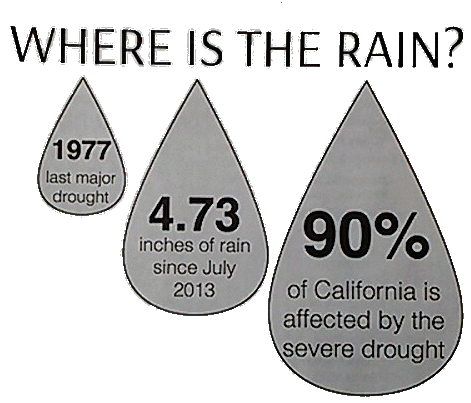Quick tips to conserve water during the drought
It has been over 10 years since California has faced a drought. As Governor Brown declares a state of emergency, urging officials to take precautions to prepare for the drought, civilians should also look to save water around the house and the home. Here are six easy ways to save water in preparation for the drought.
1. Showering instead of bathing, and spending less time taking a shower are easy ways to save water in a pinch. Bathers can reduce their shower time down to 10 minutes or fewer, saving several gallons of water a week. Additionally, installing low flow showerheads, which maintain high water pressure, will reduce water usage by 20 to 60 percent, saving 500 to 800 gallons per month, according to Energy.Gov.
2. Installing water reducing devices is a great way to prepare for the drought. Consider using the aforementioned low flow showerheads to control the amount of water on faucets and toilets. Dual flush toilets, like those found in Nichols Hall, are also an easy way to save water. Also, immediately fix any leaks in toilets or faucets. Fixing one leaky faucet saves over 3000 gallons of water a year as stated by the United States Environmental Protection Agency and is a quick and easy way to save both water and money.
The Department of Water and Power advises California residents to quickly check plumbing and faucets to reduce the risk of leaks. “Fix leaky faucets, plumbing joints and your sprinkler system. Saves 20 gallons a day for every leak stopped,” they said.
3. When washing dishes or clothes, run less loads, and use the dishwasher or washing machine only with a full load. This can save up to 400 gallons of water per month. Designating one glass of drinking water each day also reduces the amount of times needed to run the dishwasher. Replacing old washers with Energy Star washers will also help reduce water consumption, as Energy Star washers use up to 50 percent less water, according to the Energy Star website.
4. Watering yards uses several gallons of water, but it is easy to quickly become efficient with water usage. Use compost and mulch when planting, as they help retain moisture in the soil and help control weeds that will compete with the plants for water. Adjust the sprinklers so that the water only lands on the lawn, and also set up a rain barrel to help collect excess water.
UC Cooperative Extension advisor in Sacramento County, Chuck Ingels, said in a press release that the easiest way to save water is to conserve it outdoors, due to the cooler spring weather.
“Trees, shrubs, flowers, and lawns naturally use less water in winter’s cool temperatures, and so an inch of rain provides enough moisture to forego the need for sprinklers for up to several weeks depending on temperatures,” he said.
5. Instead of running the tap every time drinking water is needed, store drinking water inside the refrigerator. Catch the cold water that comes out of a faucet or sink while waiting for hot water and use it to water plants or even pour back into the toilet reservoir after flushing.
6. The simplest way, by far, to save water is to simply turn off water when it is not necessary. By turning off the water tap while brushing or shaving, one can save over 100 gallons of water a week. Instead of using a dishwasher, wash dishes, or even produce, in a pan that is partially filled with water instead of letting the tap run.
Stats:
Source : California Department of Water Resources
– 4.73 inches of rain from July 2013 to March 04 2014 in San Jose
– 40% of rain that has been falling from previous years
– More than 90% of California has been impacted by the severe drought
– The last major drought occurred in 1977, incidentally also when Governor Brown held office
The U.S. Drought Monitor is jointly produced by the National Drought Mitigation Center at the University of Nebraska-Lincoln, the United States Department of Agriculture, and the National Oceanic and Atmospheric Administration. Map courtesy of ND-MC-UNL. Map as of March 4. Statistics from the California Department of Water Resources.
This article was originally published in the pages of the Winged Post on March 4, 2014

Vineet Kosaraju (12) is the STEM Editor for both Harker Aquila and Winged Post. He is a senior and has been part of the journalism program for the past...


















![“[Building nerf blasters] became this outlet of creativity for me that hasn't been matched by anything else. The process [of] making a build complete to your desire is such a painstakingly difficult process, but I've had to learn from [the skills needed from] soldering to proper painting. There's so many different options for everything, if you think about it, it exists. The best part is [that] if it doesn't exist, you can build it yourself," Ishaan Parate said.](https://harkeraquila.com/wp-content/uploads/2022/08/DSC_8149-900x604.jpg)




![“When I came into high school, I was ready to be a follower. But DECA was a game changer for me. It helped me overcome my fear of public speaking, and it's played such a major role in who I've become today. To be able to successfully lead a chapter of 150 students, an officer team and be one of the upperclassmen I once really admired is something I'm [really] proud of,” Anvitha Tummala ('21) said.](https://harkeraquila.com/wp-content/uploads/2021/07/Screen-Shot-2021-07-25-at-9.50.05-AM-900x594.png)







![“I think getting up in the morning and having a sense of purpose [is exciting]. I think without a certain amount of drive, life is kind of obsolete and mundane, and I think having that every single day is what makes each day unique and kind of makes life exciting,” Neymika Jain (12) said.](https://harkeraquila.com/wp-content/uploads/2017/06/Screen-Shot-2017-06-03-at-4.54.16-PM.png)








![“My slogan is ‘slow feet, don’t eat, and I’m hungry.’ You need to run fast to get where you are–you aren't going to get those championships if you aren't fast,” Angel Cervantes (12) said. “I want to do well in school on my tests and in track and win championships for my team. I live by that, [and] I can do that anywhere: in the classroom or on the field.”](https://harkeraquila.com/wp-content/uploads/2018/06/DSC5146-900x601.jpg)
![“[Volleyball has] taught me how to fall correctly, and another thing it taught is that you don’t have to be the best at something to be good at it. If you just hit the ball in a smart way, then it still scores points and you’re good at it. You could be a background player and still make a much bigger impact on the team than you would think,” Anya Gert (’20) said.](https://harkeraquila.com/wp-content/uploads/2020/06/AnnaGert_JinTuan_HoHPhotoEdited-600x900.jpeg)

![“I'm not nearly there yet, but [my confidence has] definitely been getting better since I was pretty shy and timid coming into Harker my freshman year. I know that there's a lot of people that are really confident in what they do, and I really admire them. Everyone's so driven and that has really pushed me to kind of try to find my own place in high school and be more confident,” Alyssa Huang (’20) said.](https://harkeraquila.com/wp-content/uploads/2020/06/AlyssaHuang_EmilyChen_HoHPhoto-900x749.jpeg)





